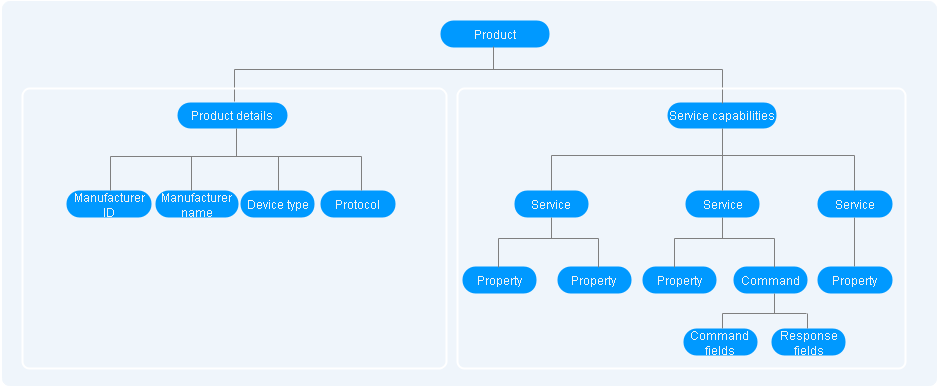Product Model Definition
A product model describes the capabilities and features of a device. You can build an abstract model of a device by defining a product model on the IoT platform so that the platform can know what services, properties, and commands are supported by the device, such as its on/off switches. After defining a product model, you can use it during device registration.

A product model defines service capabilities.
- Service capabilities
The service capabilities of a device are divided into several services. Properties, commands, and command parameters are defined for each service.
For example, a water meter has multiple capabilities. It reports the water flow, alarms, battery life, and connection data, and it receives commands too. When describing the capabilities of a water meter, the product model includes five services, each of which has its own properties or commands.
Service Name
Description
WaterMeterBasic
Defines parameters reported by the water meter, such as the water flow, temperature, and pressure. If these parameters need to be controlled or modified using commands, these parameters must be defined in the commands.
WaterMeterAlarm
Defines various scenarios where the water meter will report an alarm. Commands need to be defined if necessary.
Battery
Defines the voltage and current intensity of the water meter.
DeliverySchedule
Defines transmission rules for the water meter. Commands need to be defined if necessary.
Connectivity
Defines connectivity parameters of the water meter.

You can define the number of services as required. For example, the WaterMeterAlarm service can be further divided into WaterPressureAlarm and WaterFlowAlarm services or be integrated into the WaterMeterBasic service. The platform provides multiple methods for developing product models. You can select a method as required.
- Customize Model (online development): Build a product model from scratch. For details, see Developing a Product Model Online.
- Import from Local (offline development): Upload a local product model to the platform. For details, see Developing a Product Model Offline.
- Import from Excel: Define product functions by importing an Excel file. This method can lower the product model development threshold for developers because they only need to fill in parameters based on the Excel file. It also helps high-level developers and integrators improve the development efficiency of complex models in the industry. For example, the auto-control air conditioner model contains more than 100 service items. Developing the product model by editing the excel file greatly improves the efficiency. You can edit and adjust parameters at any time. For details, see Import from Excel.
- Import from Library: You can use a preset product model to quickly develop a product. The platform provides standard and manufacturer-specific product models. Standard product models comply with industry standards and are suitable for devices of most manufacturers in the industry. Manufacturer-specific product models are suitable for devices provided by a small number of manufacturers. You can select a product model as required.
Feedback
Was this page helpful?
Provide feedbackThank you very much for your feedback. We will continue working to improve the documentation.See the reply and handling status in My Cloud VOC.
For any further questions, feel free to contact us through the chatbot.
Chatbot





